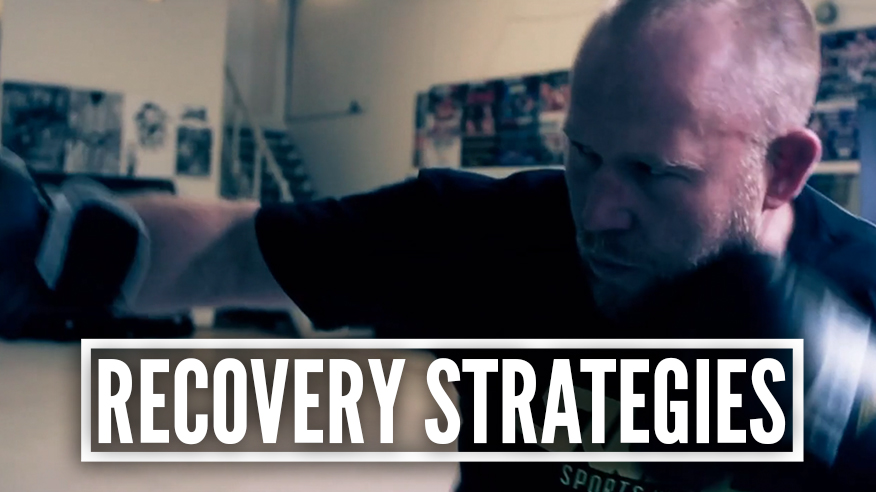Recovery and regeneration strategies have become a hot topic in the fitness world as of late, but there’s a lot more misinformation than anything else. In this week’s episode of 8WeeksOut U, I’ll share with you the details of why, when and how to use different recovery strategies to get the best results.
What are Recovery & Regeneration Strategies?
Generally speaking, the idea behind using different methods of recovery and regeneration is to “speed up” the process of recovery between training sessions and/or competitions.
Everything from EMS, to cyrotherapy, to soft tissue work and light workouts have become relatively commonplace in the training programs of many different athletes.
The real question, however, is whether or not such strategies are necessary, or even a good idea?
…And if they are useful, which methods should be used and how often should they be used?
When NOT to Use Recovery Methods…
The first thing to understand is that different methods of recovery and regeneration should absolutely NOT be used all the time.
The goal of training is to stimulate adaptation and in many ways, trying to minimize the after affects of training as much as possible can often lead to dimished results.
The trace effects of training are important for maximizing the body’s adaptive drive towards supercompensation.
In other words, don’t overuse recovery and regeneration methods if the goal is to get the best results from your training.
The Right Time to Speed up the Process
The most appropriate times to use different recovery and regeneration techniques are either A) when autonomic balance needs to be restored and B) when maximum performance needs to be achieved on a specific date, i.e. because of a competition.
This means you should really only use such methods to prevent going too far into an overreaching state and to peak for a competition, especially during a brutal competitive season with weekly, or even more frequent, competitions.
In such cases, it’s important to use different methods to help the body return to a state where it’s physically ready to perform at the highest levels.
Individualizing Recovery Methods
Aside from making sure you choose the right time to use recovery and regeneration methods, the next most important factor is to make sure to select the right recovery method for the job.
When the body is in a chronically sympathetic state, you need to choose methods that stimulate parasympathetic function and reduce sympathetic drive.
Such methods will help restore autonomic balance and prevent the cascade of negative effects that accompany prolongued exposure to stress hormones.
Using HRV is the real key to being able to individualize which recovery methods should be used. This is hugely important because using the wrong method can actually make things worse and slow down the process rather than speed it up.


Joel,
I’ve read the transcript, and I’m a little confused. In a parasympathetic state, one should reduce BOTH overall volume and overall intensity of the day? Or overall volume of the day only?
Thanks.
One should reduce the overall load to allow for recovery, which typically means a greatly reduced volume with some low amount of higher intensity being ok. A little bit of intensity can stimulate sympathetic function, but too much volume of this will only increase fatigue so it’s a slippery slope and it’s better to error on theside of caution
Nevermind. I could see the video now.
I am a little confused. It makes sense to me that if your sympathetic nervous system is too active you would use strategies to increase the parasympathetic input and balance the two systems. However, I am confused in the other case where your parasympathetic system is too active. Do you want to increase the sympathetic input? Does an increase in parasympathetic activity mean that you are “too rested?” If so, why would you decrease volume and intensity? I guess one side makes sense to me and the other doesn’t. Thanks.
too much parasympathetic activity doesn’t mean you are “too well rested” it means you have accumulated too much fatigue. You want small amount of sympathetic input to restore autonomic balance and prevent receptor downregulation. In general, you want a good autonomic balance with things slightly shifted towards the parasympathetic side. When you get too far either direction, you want to take the appropriate means to restore the balance
Awesome, thanks Joel. I think I am beginning to understand but how does an accumulation of fatigue result in too much parasympathetic activity? Is it a protective mechanism by the body to balance out the sympathetic input from training?
P.S. Thanks for your help, I have learned a lot from this 4 week conditioning program and am implementing a lot of its principles with my athletes (I am a collegiate strength and conditioning coach). This information has been invaluable.
Stewart
In simplest terms, parasympathetic is anabolic and a state of rest, repair and recovery. When the body accumulates fatigue, it decreases the sympathetic response and turns up parasympathetic function to try to get everything back to normal and reduce any further impact of more stress. It’s a natural reaction by the body on many levels, but sometimes it can be a bit too far shifted into a parasympathetic state and in such cases a low volume of sympathetic activation can shift things a bit back towards more balanced function
Hi Joel.
Joel thanks for the video, you have studys (reference) about the subject you mentioned about anit-oxidants like (1:10″/1:239″ in the video).
Thanks apreciated!
What’s the difference in protocols when it comes to active recovery for sympathetic vs parasympathetic?